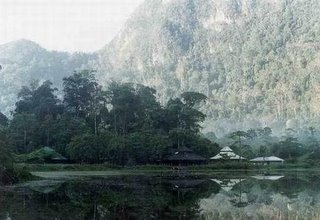Thaleban National Park - Satun - Thailand
~
Wednesday, July 12, 2006
 Thaleban National Park was declared as the 20th National Park in Thailand on 27th October 1980. The park encompasses a total area of 196km2. Thaleban is approximately 1,000 km south of Bangkok, in the province of Satun. The park covers the mountainous border area between Satun province, Thailand and Perlis state, Malaysia.The park headquaters are located in a valley which runs through the mountains, and is situated only 2kms from the border. This valley is a historic link between the two countries and this has influenced the development of the area by mixing Malaysian with the original Thai culture. The names of many park locations are actually Malaysian in origin.
Thaleban National Park was declared as the 20th National Park in Thailand on 27th October 1980. The park encompasses a total area of 196km2. Thaleban is approximately 1,000 km south of Bangkok, in the province of Satun. The park covers the mountainous border area between Satun province, Thailand and Perlis state, Malaysia.The park headquaters are located in a valley which runs through the mountains, and is situated only 2kms from the border. This valley is a historic link between the two countries and this has influenced the development of the area by mixing Malaysian with the original Thai culture. The names of many park locations are actually Malaysian in origin.
Special Features
Thaleban is a popular destination for birdwatchers with year round attraction. The park boasts a bird list of 282 recorded species and offers the opportunity of observing forest species more typical of Malaysia than Thailand. The park list currently includes 8 species of hornbill. this is more species than for any other protected area in Thailand, including such places as Khao Yai National Park which is famous for its wildlife and is over 10 times the size. The species of hornbill recorded at Thaleban are; Rhinocerous hornbill (Buceros rhinoceros), Great hornbill (B. bicornis), Helmeted hornbill (Rhinoplax vigil), Black hornbill (Anthracoceros malayanus), Wreathed hornbill (Rhyticeros undulatus), Bushy creasted hornbill (Anorrhinus galeritus), White crowned hornbill (Berenicornis comatus) and Wrinkled hornbill (Rhyticeros corrugatus). Of these species Great, Wreathed, White crowned and Bushy creasted are the most commonly encountered. Sightings of Helmeted and Black hornbill are occasional, and records of Wrinkled and Rhinoceros hornbill are very rare. The chances of seeing Hornbills varies throughout the year with the period just after nesting when the young first leave the nest being the best time to see them, at this time of year some birds form massive roosting flocks. One such flock of Great hornbills included over 130 birds which came to roost in the trees overlooking the lake.
Of these species Great, Wreathed, White crowned and Bushy creasted are the most commonly encountered. Sightings of Helmeted and Black hornbill are occasional, and records of Wrinkled and Rhinoceros hornbill are very rare. The chances of seeing Hornbills varies throughout the year with the period just after nesting when the young first leave the nest being the best time to see them, at this time of year some birds form massive roosting flocks. One such flock of Great hornbills included over 130 birds which came to roost in the trees overlooking the lake. Another attraction is the seasonal migration of Raptors which fly over the park. In October and March each year. The flocks of raptors follow the valley as they migrate between north and south. The migrations only last a few days and vary depending upon weather conditions, but at its peak over 1,000 birds pass over the headquaters in 24 hours.
Another attraction is the seasonal migration of Raptors which fly over the park. In October and March each year. The flocks of raptors follow the valley as they migrate between north and south. The migrations only last a few days and vary depending upon weather conditions, but at its peak over 1,000 birds pass over the headquaters in 24 hours.
0 comments:
Post a Comment